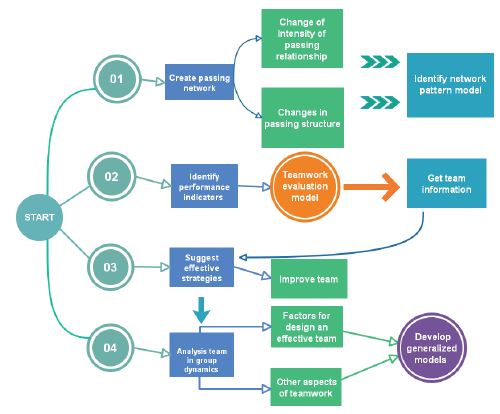Graph Neural Network Recommendation System for Football Formation
DOI:
https://doi.org/10.5281/zenodo.12198843Keywords:
reinforcement learning, clustering network, evaluation system, graph networkAbstract
In usual, the flow of a football game have different phase, and change from one to another, and the coach is due to observe them, understand and solve the tasks in the game by using appropriate structural strategies.
Therefore, it is a critical issues for a coach to decide what kind of structural strategies have been effective for their own team. Therefore, we propose 3 different views to help to the coach to make decisions. First of views, we formulate the passing ball path as a network (passing net- work. More specific, we utilize clustering coeffcient to determine the relations between players. It turnouts that core player will have a strong cluster ability. And our propose network focus not only on local network, but global passing relations.-Final of views, we propose a novel reinforcement learning based Graph-to- Graph framework to decide structure of team. We formulate the positions of players as a graph, and we use the current graph as input, while our deigns return award will effect the structure of team by change the positions step by step. In experiment, we simulate the result of our team versus 3 different level team.
Downloads
References
Li, Zhenglin, et al. (2023). Stock market analysis and prediction using LSTM: A case study on technology stocks. Innovations in Applied Engineering and Technology (2023), 1-6.
Hong, Bo, et al. (2024). The application of artificial intelligence technology in assembly techniques within the industrial sector. Journal of Artificial Intelligence General Science (JAIGS), 5(1), 1-12.
Zhou, Chang, et al. (2024). Optimizing search advertising strategies: Integrating reinforcement learning with generalized second-price auctions for enhanced ad ranking and bidding. arXiv preprint arXiv:2405.13381.
Li, Shaojie, Yuhong Mo, & Zhenglin Li. (2022). Automated pneumonia detection in chest x-ray images using deep learning model. Innovations in Applied Engineering and Technology, 1-6.
Zhou, Chang, et al. (2024). Optimizing search advertising strategies: Integrating reinforcement learning with generalized second-price auctions for enhanced ad ranking and bidding. arXiv preprint arXiv:2405.13381.
Mo, Yuhong, et al. (2024). Password complexity prediction based on roberta algorithm. Applied Science and Engineering Journal for Advanced Research, 3(3), 1-5.
Jin, Jiajun, et al. (2024). Enhancing federated semi-supervised learning with out-of-distribution filtering amidst class mismatches. Journal of Computer Technology and Applied Mathematics, 1(1), 100-108.
Dai, Shuying, et al. (2024). AI-based NLP section discusses the application and effect of bag-of-words models and TF-IDF in NLP tasks. Journal of Artificial Intelligence General science (JAIGS), 5(1), 13-21.
Mo, Yuhong, et al. (2024). Large Language Model (LLM) AI text generation detection based on transformer deep learning algorithm. International Journal of Engineering and Management Research, 14(2), 154-159.
Song, Jintong, et al. (2024). A comprehensive evaluation and comparison of enhanced learning methods. Academic Journal of Science and Technology, 10(3), 167-171.
Dai, Shuying, et al. (2024). The cloud-based design of unmanned constant temperature food delivery trolley in the context of artificial intelligence. Journal of Computer Technology and Applied Mathematics, 1(1), 6-12.
Liu, Tianrui, et al. (2024). Spam detection and classification based on distilbert deep learning algorithm. Applied Science and Engineering Journal for Advanced Research, 3(3), 6-10.
Mo, Yuhong, et al. (2024). Make scale invariant feature transform “Fly” with CUDA. International Journal of Engineering and Management Research, 14(3), 38-45.
He, Shuyao, et al. (2024). Lidar and monocular sensor fusion depth estimation. Applied Science and Engineering Journal for Advanced Research, 3(3), 20-26.
Samir Elhedhli, Zichao Li, James, & H. Bookbinder. (2017). Airfreight forwarding under system-wide and double discounts. EURO Journal on Transportation and Logistics, 6(2), 165–83. https://doi.org/10.1007/s13676-015-0093-5.
Liu, Jihang, et al. (2024). Unraveling large language models: From evolution to ethical implications-introduction to large language models. World Scientific Research Journal, 10(5), 97-102.
Lin, Zheng, et al. (2024). Text sentiment detection and classification based on integrated learning algorithm. Applied Science and Engineering Journal for Advanced Research, 3(3), 27-33.
Zhao, Peng, et al. (2024). Task allocation planning based on hierarchical task network for national economic mobilization. Journal of Artificial Intelligence General Science, 5(1), 22-31.
Zhu, Armando, et al. (2024). Cross-task multi-branch vision transformer for facial expression and mask wearing classification. arXiv preprint arXiv:2404.14606.
Li, Keqin, et al. (2024). Utilizing deep learning to optimize software development processes. arXiv preprint arXiv:2404.13630.
Li, Keqin, et al. (2024). The application of augmented reality (ar) in remote work and education. arXiv preprint arXiv:2404.10579.
Wang, Jin, et al. (2024). Research on emotionally intelligent dialogue generation based on automatic dialogue system. arXiv preprint arXiv:2404.11447.
C. Zhou, Y. Zhao, Y. Zou, J. Cao, W. Fan, Y. Zhao, & C. Chiyu. (2024 May). Predict click-through rates with deep interest network model in e-commerce advertising.
C. Zhou, Y. Zhao, S. Liu, Y. Zhao, X. Li, & C. Cheng. (2024). Research on driver facial fatigue detection based on yolov8 model. ResearchGate.

Downloads
Published
How to Cite
Issue
Section
ARK
License
Copyright (c) 2024 Zeyu Wang, Yue Zhu, Zichao Li, Zhuoyue Wang, Hao Qin, Xinqi Liu

This work is licensed under a Creative Commons Attribution 4.0 International License.
Research Articles in 'Applied Science and Biotechnology Journal for Advanced Research' are Open Access articles published under the Creative Commons CC BY License Creative Commons Attribution 4.0 International License http://creativecommons.org/licenses/by/4.0/. This license allows you to share – copy and redistribute the material in any medium or format. Adapt – remix, transform, and build upon the material for any purpose, even commercially.










